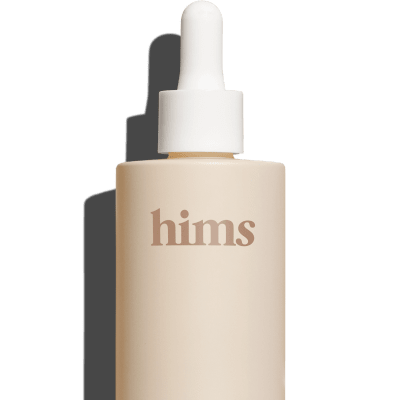Content
Regrow hair in as few as 3-6 months
Saw Palmetto for Hair Loss: Is It Effective?

Considering 30 to 50 percent of men are affected by hair loss by age 50 — it’s no surprise that some turn to herbal remedies like saw palmetto.
A plant extract often found in hair loss supplements and shampoo for thinning hair (including DHT-blocking shampoos), saw palmetto extract may be an effective hair loss treatment. But supporting research is limited.
Below, we dig into what saw palmetto is and discuss whether saw palmetto hair loss treatment really works — or if you should try other treatment options for hair loss.
Content
What Is Saw Palmetto?
Saw palmetto is a palm tree found mostly in the southeastern United States, which also answers to the scientific name Serenoa repens.
It may help alleviate symptoms linked to an enlarged prostate gland, also known as benign prostatic hyperplasia (BPH). It’s also sometimes used to treat chronic pelvic pain, migraines, and other conditions.
But what does this have to do with hair loss?
It has to do with DHT or dihydrotestosterone, a male androgen hormone associated with hair loss.
While DHT makes facial hair grow and voices deepen during puberty, it also shrinks hair follicles in a process called hair miniaturization. Smaller follicles mean thinner, patchy hair and hair loss in men — also known as androgenetic alopecia or androgenic alopecia, the clinical terms for pattern hair loss or male pattern baldness.
To treat hair loss caused by DHT, ingredients known as DHT-blockers like the prescription medication finasteride (the active ingredient in Propecia®) work as a shield to help hair grow.
One of the main saw palmetto benefits is that it also appears to partially block DHT.
All about hair, here
The Different Forms of Saw Palmetto
Saw palmetto may be a buzzy ingredient these days, but it’s not new. It has a long history as a folk medicine ingredient, with records showing Native American tribes used it to treat urinary and reproductive health problems.
You may see it as an oil extract, dried berries, powder capsules, or tea (though the fatty acids in saw palmetto aren’t water-soluble, so tea doesn’t really do much).
For hair loss, it’s often applied topically via shampoo or serum. Our thickening shampoo with saw palmetto is a safe, easy way to use this natural ingredient. More research is needed, but some findings on saw palmetto and hair loss show that the supplement may help treat it.
Does Saw Palmetto Block DHT?
Saw palmetto does block DHT — at least in part. The harder thing to answer is to what extent it blocks the hormone.
A 2012 study of 100 men with mild to moderate male androgenetic alopecia showed that 38 percent of patients treated with saw palmetto had an increase in hair growth compared to 68 percent of those treated with finasteride who noticed an improvement. But even finasteride doesn’t completely block DHT.
While there isn’t a ton of evidence supporting the idea that saw palmetto is effective against hair loss, that doesn’t mean it’s not.
Dietary supplements usually don’t require approval from the FDA (U.S. Food and Drug Administration) and often aren’t studied as much as their prescription counterparts. This may explain why there’s more anecdotal evidence than clinical trials that suggest saw palmetto works as a hair loss treatment.
That said, some studies do exist. A 2009 review found that saw palmetto is the most popular botanically derived 5-alpha reductase inhibitor (5-ARI).
Another meta-analysis looked at both oral and topical saw palmetto. It found that 60 percent of those studied showed improvement in overall hair quality, 27 percent showed improvement in total hair count, and just over 83 percent saw increased hair density.
Saw Palmetto Dosage for Hair Loss
Since saw palmetto is a natural supplement and haircare product ingredient rather than a medication, there’s no evidence-based dosage your healthcare provider may recommend for treating hair loss.
In the meta-analysis mentioned earlier, men were given a dose of between 100 and 320 milligrams (mg) per day.
Powder vs. Liquid Saw Palmetto Supplementation
If you’re taking saw palmetto berry powder capsules (as opposed to an oil capsule or liquid tincture), it’s important to note that this formulation usually contains much less saw palmetto than you’d find an oil-based extract.
The liquid extract is much more potent, even if the pills are the same size or contain the same number of milligrams. This means the powder may not have enough fatty acids or phytosterols to be effective against hair loss. It’s also potentially dangerous for those using saw palmetto to treat BPH and boost their prostate health.
When using saw palmetto, always check the instructions on the packaging for information about the recommended dosage. It’s also best to get medical advice from a your healthcare provider or dermatologist before taking any oral supplement or using a haircare product containing saw palmetto as an active ingredient.
Will you join thousands of happy customers?
4.5 average rating
Side Effects of Saw Palmetto for Hair
If you’ve ever seen a drug commercial, you know every medication and supplement has some side effects. Saw palmetto is no exception, though the side effects are generally mild.
Some may experience stomach discomfort after taking saw palmetto, which can usually be alleviated by eating first.
There’s also a risk that self-medicating with saw palmetto (or any medication that reduces levels of the 5-alpha reductase enzyme) may delay the discovery of prostate cancer.
This is because with continued use of six months to a year, saw palmetto reduces levels of prostate-specific antigen, an antigen that can indicate prostate cancer when found in high numbers. Findings on this topic are mixed, so it’s always a good idea to check with your provider if you have concerns.
Saw palmetto may also interact with other medications, like:
Blood thinner medications, such as warfarin (sold under the brand name Coumadin®), clopidogrel (Plavix®), and aspirin
Oral contraceptives, such as the birth control pill
Talk to your healthcare provider before using saw palmetto if you’re prescribed any medications.
Saw palmetto hasn’t been studied on pregnant or breastfeeding women, so should be avoided unless otherwise specified by a medical professional.
Other Ways to Promote Hair Growth
There are plenty of other hair loss treatments, some of which can be used as a complementary treatment with saw palmetto. Here are a few to consider.
Finasteride
We touched on finasteride earlier, so we’ll keep this brief. This hair loss medication was FDA-approved in 1997 as a treatment for androgenetic alopecia for men at a 1-milligram daily dose. At a higher 5-milligram dose, it’s approved to treat BPH.
Minoxidil
Minoxidil (brand name: Rogaine®) is an FDA-approved medication for hair loss. It’s a vasodilator — in non-medical speak, that means it widens blood vessels, bringing blood, oxygen, and nutrients to the scalp.
This medication also shortens the telogen phase of the hair growth cycle, thereby extending the anagen (growth) phase, and increases hair length and diameter.
We offer minoxidil foam and minoxidil liquid solution at 5% strength. They’re both applied directly to the scalp, but those with longer or thicker hair may find the solution easier to use since the dropper allows you to really get in there.
On the other hand, minoxidil foam may be a better option for folks with sensitive skin or anyone who’s experienced irritation with the medication in the past. The foam doesn’t contain propylene glycol, which some researchers think may be responsible for adverse reactions.
Finasteride-Minoxidil Combinations
A 2019 meta-analysis found that when used in combination, finasteride and topical minoxidil are more effective but just as safe as using one or the other on its own.
Our topical finasteride and minoxidil spray makes it easy to apply this iconic duo at once.
Biotin
Biotin helps produce a protein known as keratin, which hair is literally made of. A biotin deficiency is rare, though it could be the reason your hair is falling out — especially if you follow a strict diet.
Our biotin gummies unsurprisingly contain biotin as well as other ingredients essential for healthy hair, like vitamin B6, vitamin D, and folic acid.
Volumizing Hair Products
Volumizing shampoo and volumizing conditioner are like the mascara of the scalp world. While they make hair look fuller and longer, the results aren’t permanent. Still, it’s a great fake-it-til-you-make-it solution, especially when used in tandem with other hair loss treatments.
We also have a dandruff detox shampoo (made with pyrithione zinc 1% and salicylic acid) that helps keep hair flake-free so it looks clean and healthy.
Hair loss treatments, delivered
The Verdict on Saw Palmetto for Hair
So, does saw palmetto work? If you’re beginning to notice the signs of hair loss, saw palmetto can be a powerful addition to your hair health routine.
Here’s the deal:
Saw palmetto is a type of palm tree. Oil from the saw palmetto berry is extracted to help treat certain health conditions, including hair loss and prostate enlargement.
More research is needed, but saw palmetto shows promise in helping with hair loss that has a hormonal cause, like androgenic alopecia. However, since it works by blocking DHT, it won’t be effective in aiding hair regrowth from non-hormonal types of hair loss like telogen effluvium (aka hair loss from stress).
Finasteride, minoxidil, minoxidil alternatives, finasteride-minoxidil combos, and biotin can all help prevent hair loss and promote hair growth too. If you’re worried about saw palmetto side effects or want to try a more scientifically proven approach, you can find an alternate treatment.
Want to learn more about protecting your hair? Our guide to preventing hair loss goes into detail about how to gain control over male pattern baldness using a mix of medications, lifestyle changes, and more.
18 Sources
- Murugusundram, S. (2009). Serenoa Repens: Does It Have Any Role in the Management of Androgenetic Alopecia? Retrieved from https://www.ncbi.nlm.nih.gov/pmc/articles/PMC2840915/
- National Center for Complementary and Integrative Health (NCCIH). (n.d.) Saw Palmetto. Retrieved from https://www.nccih.nih.gov/health/saw-palmetto
- Prager, N., Bickett, K., French, N. & Marcovici, G. (2002, April). A randomized, double-blind, placebo-controlled trial to determine the effectiveness of botanically derived inhibitors of 5-alpha-reductase in the treatment of androgenetic alopecia. Journal of Alternative and Complementary Medicine. 8 (2), 143-152. Retrieved from https://www.haargroeispecialist.nl/resources/media/saw-palmetto-beta-sitosterol.pd
- Ho, C., Sood, T., Zito, P. (2022, Oct). Androgenetic Alopecia. StatPearls Internet. Retrieved from https://www.ncbi.nlm.nih.gov/books/NBK430924/
- Kinter K., Anekar A. (2023, March). Biochemistry, Dihydrotestosterone- StatPearls Internet. Retrieved from https://www.ncbi.nlm.nih.gov/books/NBK557634/
- Evyatar Evron,E., Juhasz, M., Babadjouni, A., Atanaskova, N.Mesinkovskab(2020, Nov).Natural Hair Supplement: Friend or Foe? Saw Palmetto, a Systematic Review in Alopecia. Retrieved from https://www.ncbi.nlm.nih.gov/pmc/articles/PMC7706486/
- Kwon, Y. (2019). Use of saw palmetto (Serenoa repens) extract for benign prostatic hyperplasia. Food Science and Biotechnology. Retrieved from https://www.ncbi.nlm.nih.gov/pmc/articles/PMC6859144/
- Zito, P.M., Bistas, K.G., Syed K. (2022, Aug. 25). Finasteride- StatPearls. NCBI Bookshelf. Retrieved from https://www.ncbi.nlm.nih.gov/books/NBK513329
- U.S. Food & Drug Administration. (2022, Oct.) Questions and Answers on Dietary Supplements. https://www.fda.gov/food/information-consumers-using-dietary-supplements/questions-and-answers-dietary-supplements
- PR Newsire (2019, Aug). Leading Saw Palmetto Producer Reports That Consumers May Be Using Saw Palmetto Incorrectly in Support of Prostate Health. Retrieved from https://www.prnewswire.com/news-releases/leading-saw-palmetto-producer-reports-that-consumers-may-be-using-saw-palmetto-incorrectly-in-support-of-prostate-health-100342039.html
- Penugonda, K., & Lindshield, B. L. (2013). Fatty Acid and Phytosterol Content of Commercial Saw Palmetto Supplements. Nutrients, 5(9), 3617-3633. Retrieved from https://www.ncbi.nlm.nih.gov/pmc/articles/PMC3798925/
- American Cancer Society. (n.d.) Screening Tests for Prostate Cancer. Retrieved from https://www.cancer.org/cancer/types/prostate-cancer/detection-diagnosis-staging/tests.html
- Tachjian, A., Maria, V., & Jahangir, A. (2010). Use of Herbal Products and Potential Interactions in Patients With Cardiovascular Diseases. Journal of the American College of Cardiology. Retrieved from https://www.ncbi.nlm.nih.gov/pmc/articles/PMC2831618/
- NIH.(n.d.) Dietary Supplements: A Framework for Evaluating Safety.
- Appendix K: Prototype Focused Monograph: Review of Antiandrogenic Risks of Saw Palmetto Ingestion by Women. Retrieved from https://www.ncbi.nlm.nih.gov/books/NBK216069/
- Chen, L., Zheng, J., Wang, L., Wang, H., Chen, B. (2019, Nov). The Efficacy and Safety of Finasteride Combined with Topical Minoxidil for Androgenetic Alopecia: A Systematic Review and Meta-analysis. Retrieved from https://cdn.mednet.co.il/2012/05/the-efficacy-and-safety-of-finasterideminoxidil.pdf
- Patel, P., Nessel, T., Kumar, D. (2023). Minoxidil-StatPearls. Retrieved from https://www.ncbi.nlm.nih.gov/books/NBK482378/
- Friedman, E., Friedman, P., Cohen, D., Washenik, K. (2002). Allergic contact dermatitis to topical minoxidil solution: etiology and treatment. https://pubmed.ncbi.nlm.nih.gov/11807448/
Editorial Standards
Hims & Hers has strict sourcing guidelines to ensure our content is accurate and current. We rely on peer-reviewed studies, academic research institutions, and medical associations. We strive to use primary sources and refrain from using tertiary references. See a mistake? Let us know at [email protected]!
This article is for informational purposes only and does not constitute medical advice. The information contained herein is not a substitute for and should never be relied upon for professional medical advice. Always talk to your doctor about the risks and benefits of any treatment. Learn more about our editorial standards here.
Knox Beasley, MD
Dr. Knox Beasley is a board certified dermatologist specializing in hair loss. He completed his undergraduate studies at the United States Military Academy at West Point, NY, and subsequently attended medical school at Tulane University School of Medicine in New Orleans, LA.
Dr. Beasley first began doing telemedicine during his dermatology residency in 2013 with the military, helping to diagnose dermatologic conditions in soldiers all over the world.
Dr. Beasley is board certified by the American Board of Dermatology, and is a Fellow of the American Academy of Dermatology.
Originally from Nashville, TN, Dr. Beasley currently lives in North Carolina and enjoys spending time outdoors (with sunscreen of course) with his wife and two children in his spare time.
Education
Bachelor of Science, Life Sciences. United States Military Academy.
Doctor of Medicine. Tulane University School of Medicine
Training
Dermatology Residency. San Antonio Uniformed Services Health Education Consortium
Certifications
Board Certified. American Board of Dermatology
Publications
Wilson, L. M., Beasley, K. J., Sorrells, T. C., & Johnson, V. V. (2017). Congenital neurocristic cutaneous hamartoma with poliosis: A case report. Journal of cutaneous pathology, 44(11), 974–977. https://onlinelibrary.wiley.com/doi/10.1111/cup.13027
Banta, J., Beasley, K., Kobayashi, T., & Rohena, L. (2016). Encephalocraniocutaneous lipomatosis (Haberland syndrome): A mild case with bilateral cutaneous and ocular involvement. JAAD case reports, 2(2), 150–152. https://www.ncbi.nlm.nih.gov/pmc/articles/PMC4867906/
Patterson, A. T., Beasley, K. J., & Kobayashi, T. T. (2016). Fibroelastolytic papulosis: histopathologic confirmation of disease spectrum variants in a single case. Journal of cutaneous pathology, 43(2), 142–147. https://onlinelibrary.wiley.com/doi/10.1111/cup.12569
Beasley, K., Panach, K., & Dominguez, A. R. (2016). Disseminated Candida tropicalis presenting with Ecthyma-Gangrenosum-like Lesions. Dermatology online journal, 22(1), 13030/qt7vg4n68j. https://pubmed.ncbi.nlm.nih.gov/26990472/
Kimes, K., Beasley, K., & Dalton, S. R. (2015). Eruptive milia and comedones during treatment with dovitinib. Dermatology online journal, 21(9), 13030/qt8kw141mb. https://pubmed.ncbi.nlm.nih.gov/26437285/
Miladi, A., Thomas, B. C., Beasley, K., & Meyerle, J. (2015). Angioimmunoblastic t-cell lymphoma presenting as purpura fulminans. Cutis, 95(2), 113–115. https://pubmed.ncbi.nlm.nih.gov/25750965/
Beasley K, Dai JM, Brown P, Lenz B, Hivnor CM. (2013). Ablative Fractional Versus Nonablative Fractional Lasers – Where Are We and How Do We Compare Differing Products?. Curr Dermatol Rep, 2, 135–143. https://idp.springer.com/authorize?response_type=cookie&client_id=springerlink&redirect_uri=https%3A%2F%2Flink.springer.com%2Farticle%2F10.1007%2Fs13671-013-0043-0
Siami P, Beasley K, Woolen S, Zahn J. (2012). A retrospective study evaluating the efficacy and tolerability of intra-abdominal once-yearly histrelin acetate subcutaneous implant in patients with advanced prostate cancer. UroToday Int J, June 5(3), art 26. https://www.urotoday.com/volume-5-2012/vol-5-issue-3/51132-a-retrospective-study-evaluating-the-efficacy-and-tolerability-of-intra-abdominal-once-yearly-histrelin-acetate-subcutaneous-implants-in-patients-with-advanced-prostate-cancer.html
Siami P, Beasley K. (2012). Dutasteride with As-Needed Tamsulosin in Men at Risk of Benign Prostate Hypertrophy Progression. UroToday Int J, Feb 5(1), art 93. https://www.urotoday.com/volume-5-2012/vol-5-issue-1/48691-dutasteride-with-as-needed-tamsulosin-in-men-at-risk-of-benign-prostatic-hypertrophy-progression.html





